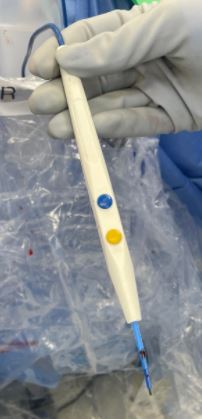Bovie Monopolar

Electrocautery very specifically refers to direct current circuits. This is in contrast to electrosurgery in which alternating current is used. This distinction matters because in direct current circuits, current does not enter the patient. Typically, direct current is used to heat an element that comes in contact with tissue. With electrosurgery, the patient is part of the circuit and the current enters the patient.
Typically, in the OR alternating current is used. In general, if the patient is attached to a grounding pad, then generally alternating current is being used. The alternating current that passes through the patient has a frequency. This is the frequency of alternation in current. This is important because the frequency transmitted can affect tissues differently. Typical electrical current alternates at 60 Hz which can lead to muscular or nervous stimulation. Frequencies in excess of 100kHz typically exceed muscle or nervous tissue ability to sense/respond therefore don’t typically react. Therefore, the unit that you see in the OR (electrosurgical transformer), transforms outlet 60Hz to frequencies over 200kHz (manufacturer dependent).
When using bovie monopolar, a circuit must be completed for there to be a flow of current. Therefore, one of the active electrodes is the bovie tip. The other electrode is the “grounding pad” that is typically attached to the patient leg. The current therefore is able to complete the circuit and pass from bovie electrode to grounding pad.
The transformer is able to alter the electrical current’s waveform which changes the effects on the active electrode and subsequently on the tissue. The waveforms in general affect the production of heat at the active electrode. Waveforms that are continuous is associated with the cut function on a bovie. The continuous waveform leads to rapid generation of heat as current heats materials (bovie tip) and tissue it passes through. This heat leads to vaporization of tissue when held slightly away from the tissue. Holding the tip away from the tissue increases the resistance to current which leads to increased current since the voltage is constant. This increased current leads to increased heat at the tissue as current passes through tissue. However, when the cut function is used with the tip in direct contact with tissue, there is less resistance and therefore less heat generation. Therefore, with less heat, tissue vaporization does not occur and instead leads to tissue desiccation. If left on the tissue for a long enough time then a coagulum will form. The desiccation/shrinking of tissue and formation of coagulum creates a discontinuity in the tissue (effectively cutting the tissue).
The coagulation function has an intermittent waveform so that the current is only intermittently on. This produces less heat leading to formation of tissue coagulum rather than vaporization of tissue. The coagulum can aid in hemostasis. However, coagulum can also inhibit wound healing across cut edges that might need to be reapproximated later. Therefore, the general rule is to use bovie sparingly, or enough to achieve the purpose without leading to an excess of coagulum.
These electrical properties can have further clinical implications regarding selectivity of tissue being “cut.” For instance, in spinal surgeries there are cases of the bovie cutting the thecal sac despite still performing a subperiosteal dissection of the overlying lamina. The general thought is usually that the operator violated the thecal sac through the interlaminar space. Alternatively, from an electronic standpoint, the flow of current follows the path of least resistance. Bone is more resistant than thecal sac and CSF. Therefore, it is possible that the current passes through the thecal sac and leads to a violation in the dura. Possible ways to avoid this is to mechanically dissect tissue off of lamina at this point. Some might argue that decreasing the voltage could mitigate some risk. This could work if the voltage is not sufficient to overcome the resistance however the voltage does not decrease the path of least resistance so you could still get a durotomy.
So how do we control the effects of the bovie? This is typically done by adjusting the transformer. Numbers shown on the generator unit are typically watts. Watts are a measure of power. This gets a little tricky since voltage is adjusted automatically by the generator depending on tissue resistance to maintain a specific power output. Adjusting the voltage automatically has ramifications for the current. In order to maintain the watts for a lower resistance the current increases. Higher resistances lead to a lower current when power setting (watts) is maintained. Power is the controlled allowing for variable voltages since a sustained voltage would lead to significantly different currents when dissecting different tissue. This would lead to either undesired clinical goals (not cutting on some tissues and fulguration at other tissues) or the need to frequently change voltage depending on clinical goal.
As a side note, wrapping the wire from the bovie around a metal clamp can lead to the creation of a small circuit within the clamp and possible generation of enough heat to start a fire. Therefore, don’t wrap wires around metal clamps.